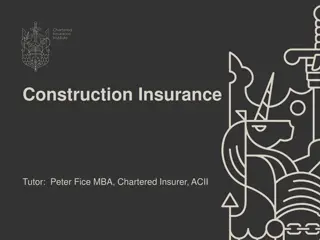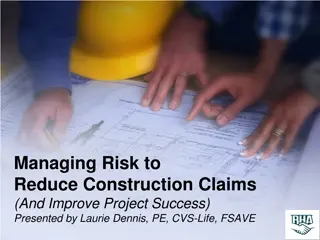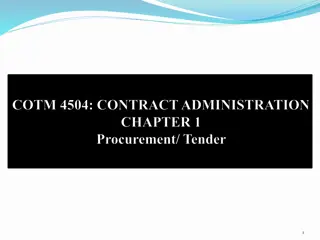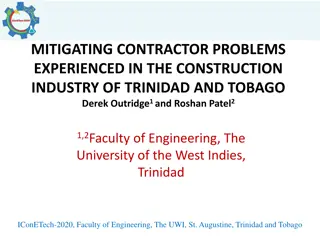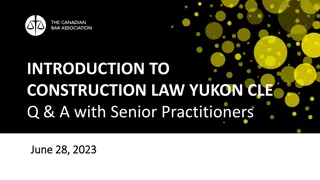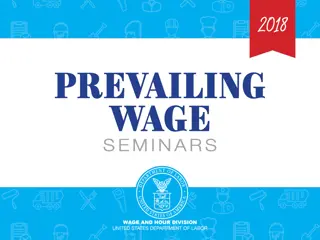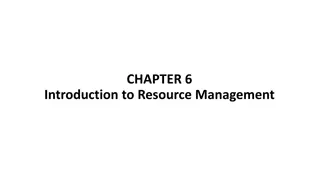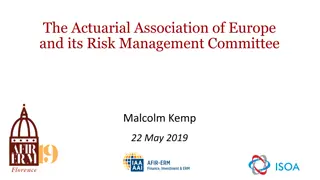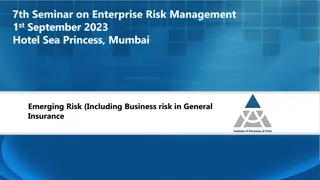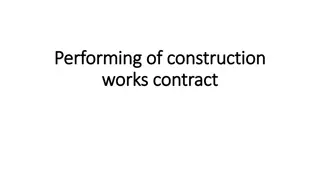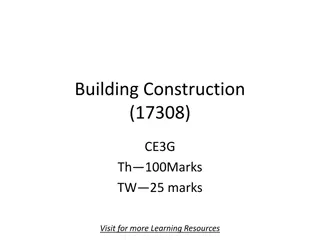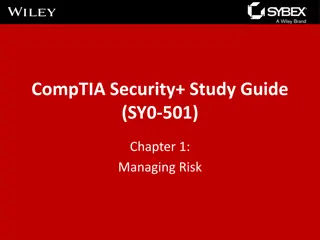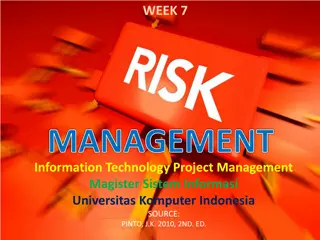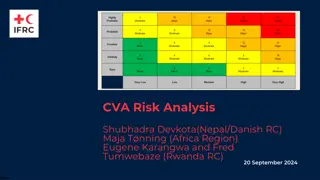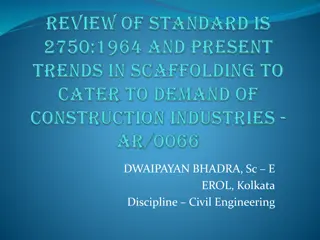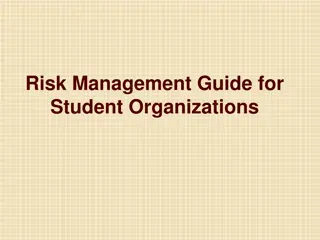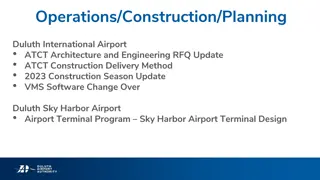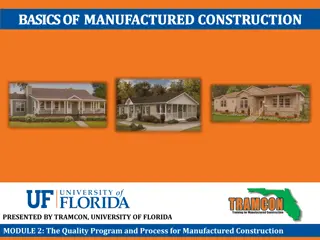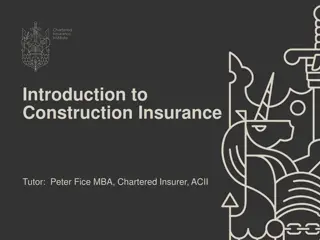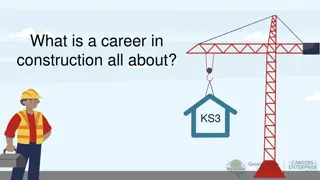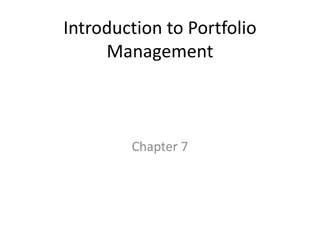Recurring Issues Impacting Risk Management in Construction Industry
Explore recurring issues affecting risk management in the construction industry, including contractual risk allocations, common risks to monitor, and case studies like the Statute of Repose scenario. Learn about risk allocation through contract clauses and how legal doctrines play a role in mitigating potential liabilities.
Download Presentation

Please find below an Image/Link to download the presentation.
The content on the website is provided AS IS for your information and personal use only. It may not be sold, licensed, or shared on other websites without obtaining consent from the author. Download presentation by click this link. If you encounter any issues during the download, it is possible that the publisher has removed the file from their server.
E N D
Presentation Transcript
Recurring Issues That Impact Risk Recurring Issues That Impact Risk Management Assessment in the Management Assessment in the Construction Industry Construction Industry Presented by Jason R. Harley McDonald Hopkins LLC Tel. (614) 458-0025 JHarley@mcdonaldhopkins.com
AGENDA Contractual Allocations of Risk Recurring Fact Patterns and Lessons Learned Conclusion/Questions
Risks to keep an eye on--- Financial - Project may cost more than planned Time - Project may not complete within planned time Design - Project may not perform the function as planned, lifecycle costs Quality - Project may have poor value, quality materials or workmanship Site risks - Students, Parents, Staff, neighbors, regulatory environment, geological characteristics, underground conditions, other buildings. Project itself - Uniqueness, complexity, new technology, backfilling of existing space, operations, renovations.
RISK ALLOCATION THROUGH CONTRACT CLAUSES RISK ALLOCATION THROUGH CONTRACT CLAUSES Spearin Doctrine implied warranty of plans Differing Site Conditions Clause Changes Clause Schedule Clause No Damage for Delay Clause Notice Clause Contingent Payment Clause Indemnity/Hold Harmless Clause
Fact Pattern No. 1 - Statute of Repose Seven unit condominium project construction completed in 1990 In 2003 one resident noticed cracks in the wall of his garage Investigation determined footings were not placed below the frost line Condo association filed suit against builder in December 2005
Fact Pattern No. 1 - Statute of Repose Suit was voluntarily dismissed and then re-filed in 2007 Contractor moved for dismissal saying the statute of repose in effect as of April 2005 barred all claims that accrued more than ten years after the date of substantial completion in 1990. Trial court and appellate court agreed
Fact Pattern No. 1 - Statute of Repose Ohio Supreme Court determined that because the Board was informed of construction problems in October 2003, applying the statute of repose that did not become effective until 2005 was applied retroactively and was therefore unconstitutional as to this claim.
Fact Pattern No. 1 - Statute of Repose Ohio Supreme Court did say that the claims were brought properly within the 4 year statute of limitations based on the discovery rule. Defects were discovered in October 2003 and lawsuit was filed in August 2007 Claims were allowed to proceed.
Fact Pattern No. 1 - Statute of Repose In the end: Construction completed in 1990 Defects not discovered until 2003 Lawsuit filed in 2007 Supreme Court decision 24 years later in 2014 Oaktree Condominium Association v. Hallmark Building Company 2014-Ohio-1937
Fact Pattern No. 2 - No Damage For Delay Construction of OPERS project in Columbus Claims caused by delay and disruption and failures to grant time extensions when requested resulting in acceleration costs
Fact Pattern No. 2 Clause in the contract provided as follows: To the fullest extent permitted by law, any extension of time granted pursuant to paragraph GC 6.2 shall be the sole remedy which may be provided by Owner, and Contractor shall not be entitled to additional compensation or mitigation of Liquidated Damages for any delay, interference, hindrance or disruption, including, without limitation, costs of acceleration, consequential damages, loss of efficiency, loss of productivity, lost opportunity costs, impact damages, lost profits or other similar remuneration. Contractor agrees that the possibility that Contractor may accelerate its performance to meet the Construction Schedule is within the contemplation of the parties and that any such acceleration is solely within the discretion of Contractor. This provision is intended to be, and shall be construed as consistent with, and not in conflict with, Section 4113.62, ORC, to the fullest extent permitted.
Fact Pattern No. 2 Contractor argued that this clause was an unenforceable no damage for delay clause. Owner argued that since these were disruption and hindrance damages the statute outlawing no damage for delay clauses did not apply. Court disagreed stating that it was delay that caused the disruption, hindrance and acceleration damages and that the statute talks about waiving liability for delay as opposed to damages for delay. Since the damages were caused by delay for which the Owner was responsible, the clause was unenforceable under the statute. Court of appeals affirmed.
Fact Pattern No. 2 - Lessons Learned Don t let an owner fool you into thinking that disruption and hindrance damages are not caused by delay. State your claim as a delay claim Cleveland Construction, Inc. v. Ohio Public Employees Retirement System 2008-Ohio-1630
Fact Pattern No. 3 - Liquidated Damages Contractor and Village entered into contract for road construction project Time limits were of the essence 120 day project duration Liquidated damages for delay $700 for each day after the specified completion date until the project was substantially completed Parties agreed to an extension of the completion date of almost year
Fact Pattern No. 3 - Liquidated Damages Contractor completed the project 397 days after the extended project completion date Village paid Contractor $535,823 of the $683,300 price under the contract Contractor filed a complaint to recover the remaining amount owed Village filed answer and counterclaim seeking liquidated damages for delay in the amount of $277,900 for 397 days of additional delay.
Fact Pattern No. 3 - Liquidated Damages A month before the expiration of the extended completion date, Contractor requested another extension Village rejected and notified Contractor by two letters: First (sent near completion date) stated it would begin assessing liquidated damages Second (sent a month after set completion date) stated that it was assessing damages as of set completion date
Fact Pattern No. 3 - Liquidated Damages Trial court found that Contractor had not followed notice requirements of contract for purposes of securing an additional time extension Owner was therefore entitled to liquidated damages in an amount which was 1/3 of the original contract amount.
Fact Pattern No. 3 - Liquidated Damages On appeal, the Court overturned the assessment of liquidated damages holding that the provision was unenforceable as a penalty given the amount versus the original contract amount. Penalty provisions in contracts are invalid on public policy grounds because a penalty attempts to coerce compliance with the contract instead of representing damages that may actually result from a failure to perform
Fact Pattern No. 3 - Liquidated Damages Agreed amounts should be treated as liquidated damages and not as a penalty, if the damages would be uncertain as to amount and difficult of proof, and if the contract as a whole is not so manifestly unconscionable, unreasonable, and disproportionate in amount as to justify the conclusion that it does not express the true intention of the parties, and if the contract is consistent with the conclusion that it was the intention of the parties that damages in the amount stated should follow the breach thereof
Fact Pattern No. 3 - Liquidated Damages Ohio Supreme Court agreed to hear the case to consider two proposition of law When evaluating the enforceability of an LDs provision, the court must conduct its analysis prospectively, based on the per diem amount of the liquidated damages at the time the contract is executed, and not retrospectively, based on the total liquidated damages that ultimately accrue. LDs are not a penalty simply because a project consists of new construction of an improvement that did not exist previously and no proof of actual damages is required to enforce liquidated damages pursuant to such a contract.
Fact Pattern No. 3 - Liquidated Damages The Court first expressly recognized the enforceability of LDs in public contracts: In a public-roadway-construction contract, each delay in completing the project adds to inconvenience, increased costs, and loss of use of the roadway But each day's delay, while unquestionably injurious, is injurious frequently in ways that are difficult to estimate.
Fact Pattern No. 3 - Liquidated Damages The Court then reversed the appellate court s application of the second part of the test contract as a whole is so manifestly unconscionable, unreasonable, and disproportionate in amount The appellate court focused on the $277,900 in LDs in relation to the $683,300 contract amount Found that the application of the LDs provision rendered it a penalty
Fact Pattern No. 3 - Liquidated Damages The correct analysis looks at whether it was conscionable to assess $700 per day in liquidated damages for each day that the contract was not completed rather than looking at the aggregate amount of the damages awarded. By the appellate court s reasoning, the provision might have been enforceable if the delay had been shorter It is a perverse rule of law to hold that a court can relieve a breaching party of the consequences it agreed to by refusing to enforce a per diem liquidated- damages provision solely because the breach was an egregious one.
Fact Pattern No. 3 - Liquidated Damages Boone Coleman Construction v. Village of Piketon 2016-Ohio-628
Fact Pattern No. 3 - Liquidated Damages Lessons Learned The important inquiry is whether the per day amount is reasonable not whether the total assessed is reasonable
Fact Pattern No. 4 - NULLUM TEMPUS OCCURRIT REGI Project on University of Cincinnati campus - -Marriott Hotel and Convention center. Finished construction in 1999. Built through a ground lease deal with no competitive bidding, with the University not holding any contracts. Was the subject of a years long bid protest that eventually held that this had been an illegal process. Was built in spite of the protest. Walsh Higgins was the developer and they entered into a series of trade contracts with other local contractors to build the facility.
Fact Pattern No. 4 cont. In 2011, University of Cincinnati sued Walsh Higgins and their designers alleging defective work and defective design that had resulted in water intrusion and mold problems. Claims against Walsh Higgins are based on a theory of third party beneficiary whereby the University was an express third party beneficiary of the contract between Walsh Higgins and the entity who agreed to provide a completed facility to the University. Designers all moved to be dismissed based on the economic loss doctrine whereby since there was no privity of contract, they could not be held responsible for purely economic loss damages. The Court agreed and dismissed those entities.
Fact Pattern No. 4 cont. Walsh Higgins argued that Ohio s ten year statute of repose bars any and all third party claims after ten years has passed since substantial completion, which is the case here. The University argued that the ancient doctrine of nullum tempus occurrit regi applies. That doctrine literally means that time does not run against the King and that no statute of limitations is ever applicable against the state. The Court agreed and has kept Walsh in the case where it said that absent express statutory provision to the contrary, the state is exempt from the operation of a generally worded statute of limitations.
Fact Pattern No. 4 cont. The Court went further to say that this applies to statues of repose as well as they are bars against recovery. The policy behind the doctrine (last cited by the Ohio Supreme court in 1988) was stated as follows: The sovereign, acting through its agents who are continually busied for the public good can on occasion be somewhat less than imbued with alactrity in preserving the rights of the public. This is as true today as it was in monarchial times.
Lessons Learned: Does not apply to municipalities, school districts and other political subdivisions. Contractors are subject forever to claims from the State, especially claims for defective construction discovered years after the fact. University of Cincinnati v. Walsh Higgins & Co., et al. (Hamilton County Common Pleas Case No. A1105831) decided Jan. 15,2013.
Fact Pattern No. 5 Ready, Fire, Aim! TA was the general-trades contractor on a Dorm Project for Ohio State School for the Blind and Ohio School for the Deaf The Ohio School Facilities Commission oversaw the Project as the owner Limited funding for the Project OSFC was over-budget from the beginning Initially planned as a single campus Change in government administration led to a decision to keep the campuses separate The budget was never changed to reflect that decision
Fact Pattern No. 5 Ready, Fire, Aim! . LL (construction manager) and SHP (architect) were authorized agents of OSFC OSFC first solicited bids by issuing unapproved plans (Bid #1) Bids came in at over 40% of advertised estimate OSFC re-bid after some bid engineering OSFC/LL had partially approved plans when it issued Bid #2, but the plans were not disclosed to the bidders OSFC/LL issued altered plans that had not been approved by DIC
Fact Pattern No. 5 Ready, Fire, Aim! OSFC awarded TA the Contract for the general trades work TA was unaware of the altered plans In February 2011, TA sent LL a letter stating that the lack of revised drawings had impacted and would continue to negatively impact TA s work LL knew that the revised drawings would not likely become available, but it made representations otherwise and concealed information from TA LL also did not inform OSFC of the delay in updated drawings Notwithstanding the lack of unambiguous plans, LL demanded TA and the other contractors to continue working
Fact Pattern No. 5 Ready, Fire, Aim! Throughout construction, TA continually provided LL/OSFC with written notice of delays caused by the confusing and incomplete drawings It could not certify and submit its claim as required by Art. 8 until the impacts could be fully realized. TA submitted its first certified claim on Mar. 8, 2012 Over time, TA learned of the behind the scenes activities i.e., active concealment LL and SHP engaged in, leading TA to file a supplemental claim on Nov. 7, 2012. OSFC/LL did not respond to the supplemental claim, and they untimely rejected the Mar. 8, 2012 claim.
Fact Pattern No. 5 Ready, Fire, Aim! TA filed a lawsuit for breach of contract OSFC s affirmative defenses Statute of Limitations Failure to Provide Notice Failure to File Art. 8 Claim For Release of Liquidated Damages
Fact Pattern No. 5 Ready, Fire, Aim! ISSUE #1: Statute of Limitations Defense R.C. 2743.16(A) requires that the action be commenced no later than two years after the date of accrual of the cause of action . . . When does the cause of action accrue? Court: cause of action is not the same as a claim under the contract A contract provision that provides the statute of limitations begins on the date the contractor is required to file its substantiated and certified Claim with the Commission has no application to the extent it is inconsistent with the provisions of R.C. 153.16(8). Cause of action accrued no earlier than TA exhausted its administrative remedies and no later than July 10, 2012 (120 days after it submitted its certified claim). Thus, OSFC s statute of limitations defense failed
Fact Pattern No. 5 Ready, Fire, Aim! ISSUE #2: Failure to Provide Notice Defense The Contract provided that if TA failed to perform specific conditions precedent to asserting a claim, such claim was irrevocably waived However, TA substantially complied with Article 8 of the contract Additionally, OSFC waived its right to enforce Article 8 [W]aiver of a contract provision may be express or implied. [B]y withholding the revised drawings from TA, disregarding its obligations under Article 8 and waiving the Article 8 procedures for other contractors on the Dorm Project, OSFC, through the authorized acts of its agent LL, knowingly and impliedly waived strict compliance with the initiation, certification and submission requirements of [Article 8].
Fact Pattern No. 5 Ready, Fire, Aim! ISSUE #2: Failure to Provide Notice Defense OSFC Prevented TA's Strict Compliance with Article 8 [A] right of action requiring notice as a condition precedent cannot be enforced unless the notice provided for has been given. Boone Coleman Construction v. Village of Piketon 2014- Ohio-2377 However, [i]f a party prevents the occurrence of a condition, the condition is excused. Crawford v. By Lamb Builders, 1993 WL 303684 (Ohio Ct. App., Franklin County Aug. 10, 1993) Ohio courts have held that something more than actual notice of a claim on the part of the state is required to excuse a contractor from complying with the claims requirements of a contract
Fact Pattern No. 5 Ready, Fire, Aim! ISSUE #2: Failure to Provide Notice Defense OSFC Prevented TA's Strict Compliance with Art. 8 Here, there was more than actual notice. OSFC, through its agent, LL, continually led TA to believe that it would be furnished updated/revised drawings, and not just once, but regularly for over five months after TA first gave written notice that it intended to file a claim By not issuing revised drawings to TA in a timely manner, OSFC, by and through its agents LL and SHP, prevented TA from complying with the conditions precedent under Art. 8
Fact Pattern No. 5 Ready, Fire, Aim! ISSUE #3: Failure to File Art. 8 Claim For Release of Liquidated Damages This defense failed for a number of reasons: A certified claim under Art. 8 serves to modify the contract, not enforce payments that are due and unpaid. In the case of wrongful withholding of liquidated damages, the wrongful withholding occurs daily. According to OSFC, TA would have to file a claim every month for return of liquidated damages. The Contract has no such requirement. Release defense was not pled affirmatively. Therefore, OSFC waived the defense.
Lessons Learned TransAmerica Building Company, Inc. v. Ohio School Facilities Commission, et al., Case No. 2013-00349 The importance of written notice (of some form) Not following contract provisions = waiving the right to enforce the contract provisions The importance of knowing who can waive your rights (your authorized agents) Ready, Fire, Aim Ready, Fire, Aim probably best describes the way the OSSB and OSD dorms were planned and built. In other words, the Dorm Project design was completed "on the fly" after award of the contract and during construction rather than being sufficiently complete and approved at the time bids were solicited.
Questions? Jason Harley: (614) 484-0715 Jharley@mcdonaldhopkins.com







